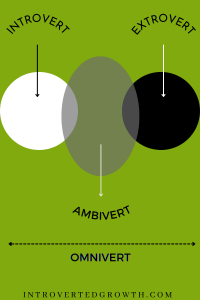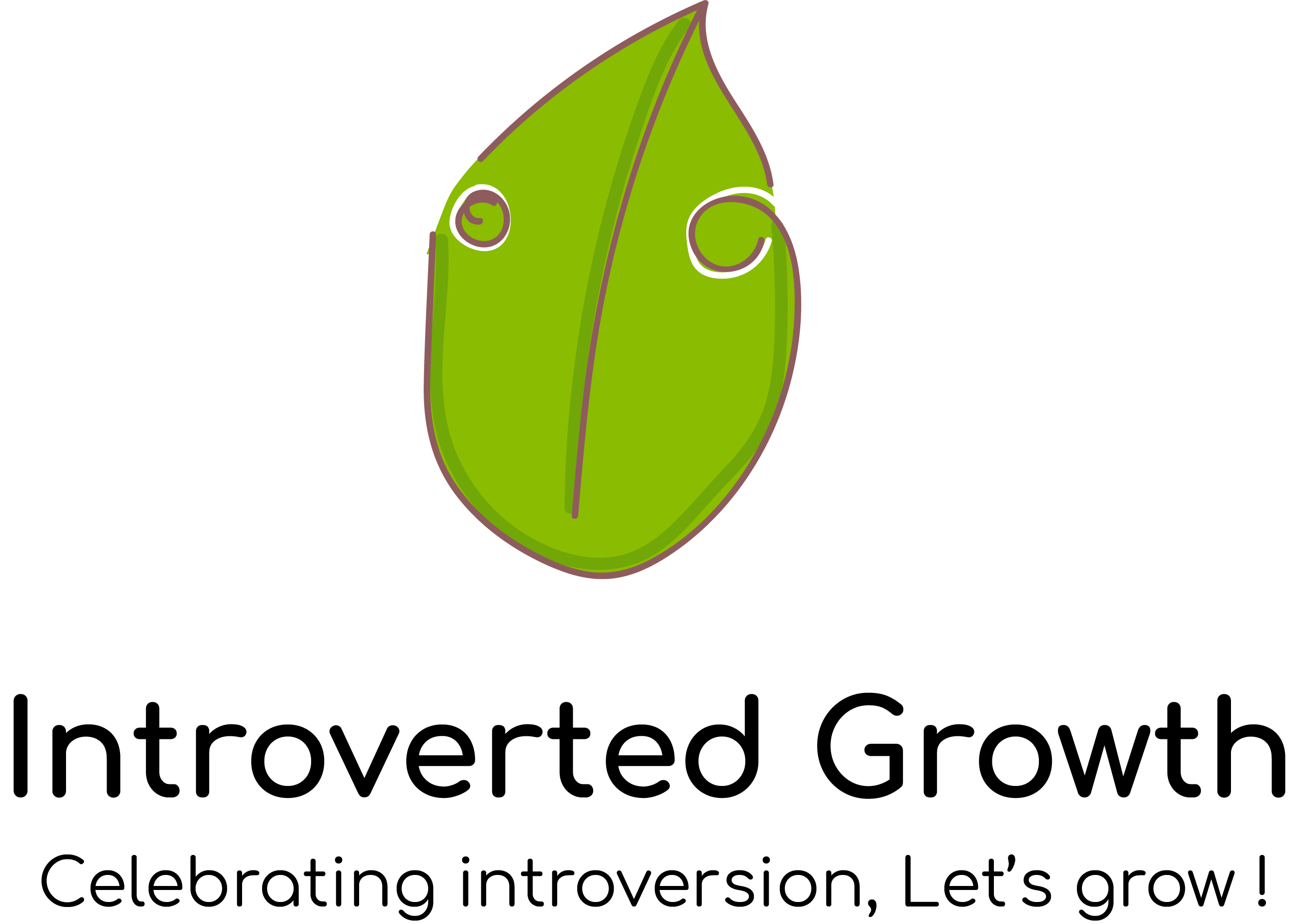If you believe you identify as neither a classic introvert nor an extrovert then you probably belong to one of the two remaining personality temperaments: ambiverts and omniverts
The tricky thing about both these temperaments is they’re similar to a certain degree and a lot of people find it hard to differentiate between the two.
That’s why today, I’m going to do a little mental exercise to help you compare the traits of an Ambivert vs Omnivert in terms of their similarities and differences.
You may want to listen to this podcast
Now, let’s begin by introducing both personality traits :
What is an ambivert
An ambivert ( also called outgoing introvert) is someone who falls somewhere in between the introvert-extrovert spectrum.
Ambiverts do not feel energized by either people or solitude, but rather experience both equally depending on the situation they experience, and that’s what makes ambiversion the most mentally stable personality temperament.
They definitely can’t be labeled as classic introverts or extroverts.
What is an omnivert
An omnivert is someone who exhibits both extroverted and introverted qualities but they rather fall in the extreme of each temperament on the spectrum depending on their inner state.
what I mean by this is that an omnivert can be a classic introvert, someone who gets overwhelmed and loses energy to people one day and a total extroverted party animal the next day. No in-between.
Ambivert VS Omnivert: Similarities
I’m sure you’ve already noticed the similarities between the two personality traits.
- Both personality traits are similar in a way that they don’t fit in clearly defined personality patterns such as the one’s introversion and extroversion fit it. That’s why people find it hard to figure out what category they fall into and especially when you don’t necessarily feel like you ‘fit’ in those identified personality types.
- Both personality traits exhibit introverted and extroverted qualities despite the fact that they don’t have steady behavior patterns but rather depend on situations and inner state.
- Both ambiverts and omniverts can’t seem to fit in a specific personality type on the Myer Briggs scale.
- Omniverts and ambiverts can both get their energy from spending time alone as well as being around people, again, depending on external and internal circumstances that we’ll get into below.
5 Examples to Understand the Omnivert Vs Ambivert
Now let’s take a look at the differences between an ambivert and omnivert so you can figure out with ease if you’re more similar to an ambivert or more like an omnivert.
1. Emotional State
Ambiverts are considered emotionally stable because they can use both their introverted and introverted qualities in the same situation if needed to get the most out of the situation experienced.
This means that they don’t experience the same mood swings like the ones experienced by an omnivert.
Omniverts can go from being very introverted to becoming an extrovert in no time and their mood changes accordingly, especially if they don’t understand their personality well.
For example, you can be feeling like doing nothing but staying indoors on Monday morning, and suddenly on Tuesday, you can feel like going to a party.
2. Energy Levels
An ambivert’s energy level goes up and down based on their external surroundings and experiences, This means that they act depending on the context of the situation they’re experiencing.
Let me explain this to you..
If you’re an ambivert, you’ll likely be able to perfectly lead a meeting in the company and show genuine enthusiasm during the meeting, you wouldn’t feel forced to act up because you’re in a meeting.
After your meeting, you’ll probably go home and also enjoy staying indoors all evening spending what you’ll consider quality time with your cat and a book.
This means that you gained energy from both being social and being alone.
Omniverts on the other hand react to their surroundings depending on their internal state. If you’re feeling overwhelmed inside, you won’t be able to go out even if it’s a party you’ve been anticipating for awhile or a date with someone you care deeply about.
You simply won’t have the energy to be outgoing and you’ll seem solitude and quiet to recharge.
But if you’re underwhelmed inside, you’ll be bubbling and lively no matter what happens around you and you’ll seek outdoor activities and socializing to get energized.
3. Development
An Ambivert’s personality is most likely to develop a stable personality compared to an omnivert.
People often find omniverts hard to get along with because their mood changes.
Ambiverts are considered more organized and mature people, unlike omniverts who are likely to be seen as emotionally unstable by some people.
This is not entirely true by any means, because people in general and even omniverts themselves don’t really understand this personality temperament, hence the pre-conceptions.
This is a matter of misinformation and the fact that there are not enough educational resources until this day about omniversion.
So if you’re used to people telling you that they don’t understand your obvious change of behavior every other day, you’re probably an omnivert.
4. Introverted and Extroverted Qualities
As mentioned above, both omniverts and ambiverts have introverted and extroverted qualities but the difference here is that ambiverts are flexible and can exhibit both qualities in the same situation but omniverts can’t do that.
Omniverts can show classic extroverted qualities in a situation and pure introverted ones in another situation.
5.Socializing
Many people find it hard to get along with omniverts because of their mood swings and how unpredictable they can be in social situations.
Ambiverts on the other hand are known for being great listeners and also have a knack for balancing out the social needs of friends and co-workers who may be going through a rough time.
Ambiverts are seen as more sociable compared to omniverts because ambiverts can adapt their energy levels according to their social interactions, depending on what is needed at the moment.

It’s All About Creating a Balance
Now, Being an ambivert or an omnivert comes with both raw benefits and drawbacks.
For example an omnivert has the ability to exhibit both extroverted and introverted qualities of character, but the drawback here is that they’re not flexible with this and may lead to unbalanced decisions and actions.
On the other hand, an omnivert can easily balance their mood swings and adjust according to each situation, but the drawback here is that this might place extra strain on the ambivert.
This means that it’s essentially a matter of trying to balance out the benefits and drawbacks of being either type.
Doing this requires working on developing one’s personality trait and gaining a better understanding of how your personality temperament dictates your behaviors.
Making a list, a journal or even a mood board is a great way to keep track of what triggers you and why! because after even though each personality trait has a defined pattern, we’re essentially unique and need to find out our own pathway.
FAQs
Am I an Omnivert or an ambivert? (ambivert vs omnivert)
To answer simply, you’re an ambivert if you can adapt yourself to all sorts of people and situations, and you’re an omnivert if you can show both extroverted and introverted qualities but not at the same time.
So next time someone asks you what type of personality do you have, just tell them that you’re a flexible person who can fit into various settings depending on what’s needed.
How do you know if you are Omnivert?
you’re an omnivert if you make hard shifts between being totally introverted one day and totally extroverted the next.
Are Ambiverts rare?
No, they’re actually the most common personality temperaments considering that people can’t be extremely introverted or extroverted and most people fall in between both extremes on the spectrum. Ambiverts actually make up 68% of the population according to Professor Barry Smith from the Maryland University.
CONCLUSION
In conclusion, I hope that this ambivert vs omnivert guide has helped you a little bit to better understand yourself and maybe others as well.
Lastly, remember that asking questions and doing research about these qualities is a great first step to understanding yourself better and finding the balance between all this mess.






